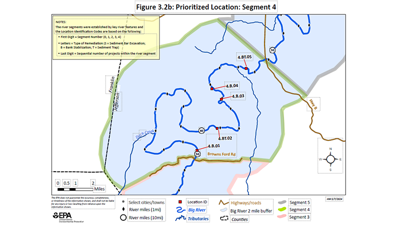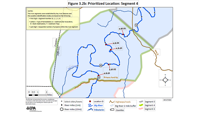The Environmental Protection Agency is prepared to spend more than $75 million in Jefferson County to remediate sections of the Big River watershed in an effort to prevent further lead contamination.
Representatives from the EPA held a meeting to share its draft restoration plan with the public on July 23 at Jefferson College in Hillsboro, and about 30 people attended, asking questions about the proposed options and how the projects may affect their properties, said EPA press officer Kellen Ashford.
The plan includes four proposed alternatives for lead remediation, ranging from alternative one, which is doing nothing to prevent further contamination and bank erosion, to alternative four, which is completing most of the proposed options in a holistic approach to restoration. Alternative four is the EPA’s preferred method, according to remedial project manager Greg Bach.
The proposed restoration plans are in response to the discovery of a high level of hazardous materials found in the watershed from mining-associated facilities like mines, mills and smelters. Parts of Jefferson County are included in the Old Lead Belt of southeast Missouri, known at one point as the leading producer of lead in the world. Other counties in the belt include St. Francois, Washington, Madison, Crawford, Iron, Dent, Reynolds and Shannon counties.
“Lead mining in southeast Missouri dates back to the early 1700s, 50 years before we were a country and 100 years before we were a state,” Bach said. “Back then, there were no environmental regulations for the disposal of waste materials. So, over the years, it’s estimated that there were 250 million tons of mining, milling and smelting-related waste that was produced in this region, and with no environmental controls or regulation, it was allowed to wash into the waterways.”
The 105-page engineering evaluation and cost analysis report may be accessed online at epa.gov/superfund/southwestjeffersoncountymining.
Ashford said his agency will accept feedback on the proposed plans through Sunday, Aug. 17. Comments may be sent to senior community involvement coordinator Elizabeth Kramer at kramer.elizabeth@epa.gov.
Comments may also be mailed to U.S. EPA Region 7, 11201 Renner Blvd., Lenexa, Kan., 66219.
Alternatives
The EPA is looking to reduce the “ongoing cycle” of lead contamination in the Big River with the alternative plans listed in the study, Bach said, adding that the alternatives mark some of the first steps in cleanup efforts within the watershed.
The second alternative in the plan focuses on stream bank stabilization.
“Stabilizing a bank is cutting off a source of (lead) contamination to the river,” Bach said. “Those stored contaminated soils that are in the floodplain release back into the river during a flood when the river bank erodes. In some cases, this could be thousands of cubic yards of contaminated material reentering the watershed.”
Bach said alternative three focuses on remediating sediment traps, such as gravel bars, where a high concentration of lead-contaminated materials is already found in the Big River.
“The fourth alternative, which is our preferred alternative, is looking at addressing both of those simultaneously,” Bach said. “We feel that this is the most effective in controlling or reducing the amount of recontamination within the river, and the combination of that bank stabilization and targeting excavation in specific locations, we feel, will have the biggest impact.”
Property rights
Bach said the draft plan breaks down the proposed work into five segments of the Big River, with some in southwestern Jefferson County and some in northern St. Francois County.
A figure on page 60 of the plan shows the sections, Bach said, with segments three and four encompassing targeted areas in Jefferson County. Segment five, also in the county, will most likely be included in a future remediation project, Bach said.
Bach stressed that while the EPA has pinpointed specific properties for lead remediation, it’s up to landowners whether or not the work gets done.
“At no point does this mean that EPA is taking over any portion of your property,” Bach said. “We do not retain property rights. The EPA operates under what we call an access agreement. It’s a voluntary permission slip saying, ‘We are allowing you on my property to do this, and when this project is done, so are you.’”
Bach said that while lead is a naturally occurring element in the county, the EPA has recorded unnatural levels of lead in the selected sites. He said those who ingest or inhale large quantities of lead may suffer harmful side effects to their health and development.
Additionally, wildlife living in or near the Big River is affected by lead, Bach said.
He said the Missouri Department of Health and Senior Services, along with the Department of Conservation, have issued “do not eat” warnings for any sunfish, carp and suckers caught in the Big River because of the high lead count found in the fish.
“The EPA recommends residents of Jefferson County have their children’s blood tested for lead, and they can reach out to the county Health Department for more information about that,” he said. “They can also reach out to their primary health care provider for getting their blood lead tested.
“But we really do encourage families to have that done. It’s the only way you can know if your child’s being exposed.”




